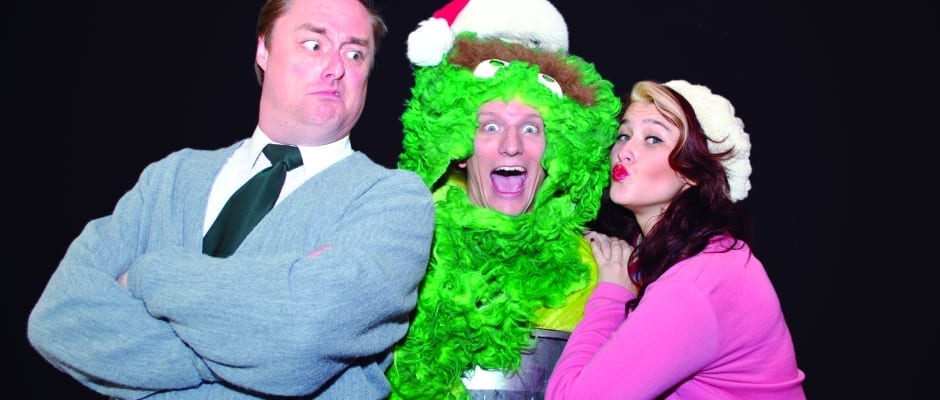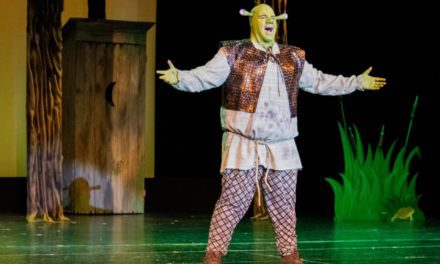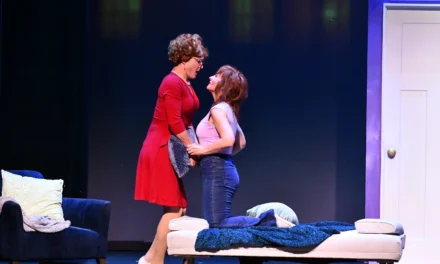SALT LAKE CITY — The Off-Broadway Theater is a delightful space. When walking down Main Street of Salt Lake City you just almost miss it, as it’s tucked in among the nearby markets and restaurants. But upon entering the doors of the auditorium, past the box office and concessions, one is taken back to a simpler time. It is a space that permeates the theatricality upon which this business was built: red curtains hang from the walls; fans line the balcony ledge for the summer heat; the occasional, almost unnoticeable cable hangs down from the lighting or sound equipment. And in the air is the passionate, yet humble spirit of theatre and also film (given the space’s history as a cineplex, apparent by the design of the audience space). I can almost hear the voices of actors passed on, proclaiming their art. This theater is a magical place.
The magic continued as I explored the stage. The set before me indicated a combination of two worlds—a Seussian Who neighborhood lay before me, curiously led by a familiar-looking green and white sign reading “SEUSSAME STREET.”
With the set and the description given online being my only knowledge thus far as to what the show would be, I was slightly confused. But I was willing to go with it, and I could feel the room was with me in that. Given the exceptional number of children in the audience, the iconic characters being used in the story, the announcement encouraging audience participation, and the opening number being all children, by the start of the show I thought I had this show figured out. “Okay,” I said to myself, “this is definitely TYA” (Theatre for Young Audiences). I felt this was important to recognize at the beginning of the show because the needs for a TYA production and the needs for an adult production are different. This is not a measurement for differences in quality—as the quality should always be superb—but a measurement in the type of story.
A quick lesson for those unfamiliar with children’s theatre: the most successful pieces of children’s theatre are stories where (a) a character that is either young, weak, or misunderstood is the protagonist; and (b) that character somehow overcomes their own flaws. The protagonist may have help, but ultimately they go through their journey themselves or they make the “big decision” in the story themselves. The best children’s stories fit this formula (i.e., Peter Pan, The Little Mermaid, Up, and more). Kids love being shown that the little guy or the underdog can overcome their obstacles.
Even How the Grinch Stole Christmas and Sesame Street fit this model. The Grinch is an outcast, just as many kids can identify with, and some of the inhabitants that live on Sesame Street are monsters, Elmo being the obvious favorite. Who can you think of that would be more misunderstood than a monster? Overall, kids like being shown that they can overcome their troubles or personal demons all by themselves. It’s empowering.
However, the Grouch Who Stole Christmas did not fit this bill of empowering stories for children. And it did not meet the necessary standard for many other attributes of children’s theatre. From the program to the marketing to the introduction of the show, this piece was parading as family-friendly theatre, if not solely children’s theatre. They were obviously looking to accomplish the delicate balance the movie How the Grinch Stole Christmas starring Jim Carrey accomplished—appropriate for all ages with jokes for the kids and jokes for the adults that are subtle enough to go over the kids’ heads. I felt this production lacked in both of those endeavors, leaving it audience-less. When a company doesn’t know the demographic they wish to appeal to, the audience therefore doesn’t know what the appeal is.
The Grouch Who Stole Christmas followed the story of Jim Henson’s Grouch living in a Whoville-Sesame Street world that he is banished from when his garbage pile is detracting from the Christmas spirit. Mr. Rod Cheers (a Mister Rogers parody), meanwhile, is plotting to steal Christmas away from Seuss-Who town simply because he’s an evil guy who is not what he seems. In the second act, when the Grouch has been banished to a mountain top, he is informed by his Who and monster friends that Mr. Rod Cheers has stolen Christmas from them all. They need Grouch’s help to steal it back. The show ends with everything being saved, and all is good and happy on “Seussame Street.” The many layers of variant conflicts and characters muddled this story however, making the plot difficult to follow.
I’m sorry to say the plot and the intended demographic weren’t the only areas that lacked focus. From the start, mashing up not only one, nor two, but three (arguably four) iconic venues of children’s entertainment was a poor choice. I felt overwhelmed and with so many elements to reference, the actors seemed overwhelmed as well. Combining Seussian Whos, Jim Hensen’s Sesame Street characters (as well as the occasional toss in of Jim Henson’s Muppets) and Mr. Rogers Neighborhood is just too much.
The writing by Eric R. Jensen was wordy and this made the tempo of the piece very slow. It was two hours into the whole show and 30 minutes into Act II when Oscar finally made the decision to go steal Christmas back from Mr. Rogers. But most of the audience wouldn’t know this is what happens, as the crowd had substantially thinned by that point in the show. When it was over, I felt dizzied by the excess of jokes inside of jokes, and the shouting quality of the Grouch’s vocalization had overwhelmed my ears. I understood why so many had bowed out early.
The direction, also by Eric R. Jensen, struggled from a tendency to put every character on stage, most of the time. By the end the play it felt to me that a little piece of action would happen and then a dozen characters would come onstage, in a line (a choice which lacked visual interest and felt boring), and talk about the action for five to ten minutes. Again, the issues in tempo this caused was frustrating. The issues in direction and writing were undivided, the problems of one fed the weaknesses of the other.
With all that said, I appreciate the company’s bold effort. The actors were absolutely dedicated to making it work and there were many distinct choices in characterization made. The highlight for me were the five children in the cast, the “Yay-Whos” (because using the word Who “would be a lawsuit,” as one of the characters jested) Hadley Nelson, Hailey Delandrae, Racheal Powell, Whitney Powell, and Skyler Jensen were marvelous “Yay-Whos,” committed to the song, the dancing, and their performance overall. They were shining beacons on stage. Beacons we would see only twice more during the whole production unfortunately, apart from Hadley Nelson, who portrayed “Susie Q. Yay-Who.”
For the adult actors, I was most impressed with Tonya Aikens, the narrator; and Ian Murray, who portrayed “Kooky Monster.” Aikens had great high energy and focused on the story itself as opposed to easy humor; Murray played for laughs but his punches were funny and direct, while his choices were bold.
Eric R. Jensen portrayed Speedy McFeely; he had a few solid comic moments, but his desire for every moment to be the Speedy McFeely comedy hour was tiring. Rusty Bringhurst, the “Grouch” himself, has a quick wit and an interesting style, but his tendency to play too many jokes within one joke muddled the Grouch’s objectives and character clarity. His tendency to play “grouchiness” and only grouchiness also gave his vocality a grating quality that was hard to listen to for an extended period. For me, Bringhurst was simply too much. Jensen and Bringhurst’s performance also hazed the clarity of the piece overall–there was a lot of joke telling, and not enough storytelling.
But as previously mentioned, the set and the costumes/puppetry designed by Eric R. Jensen, Frank Ackerman, and Aneta Clawson were stars in the piece. The set was aesthetically pleasing and believable with just the right touch of whimsy. And the costumes/puppetry (as the pieces were sort of both) were exquisite. It’s never an easy task to re-create something as iconic as Jim Henson’s work, but Big Bird looked just like the Big Bird we all know and love. I wanted to be as thrilled with the entire production as I was with these elements. In the future, I would love to see the Off Broadway Theater keep the enthusiasm in performance and excellence in design, but lose the cheap jokes, slow tempo and poor story structure.







